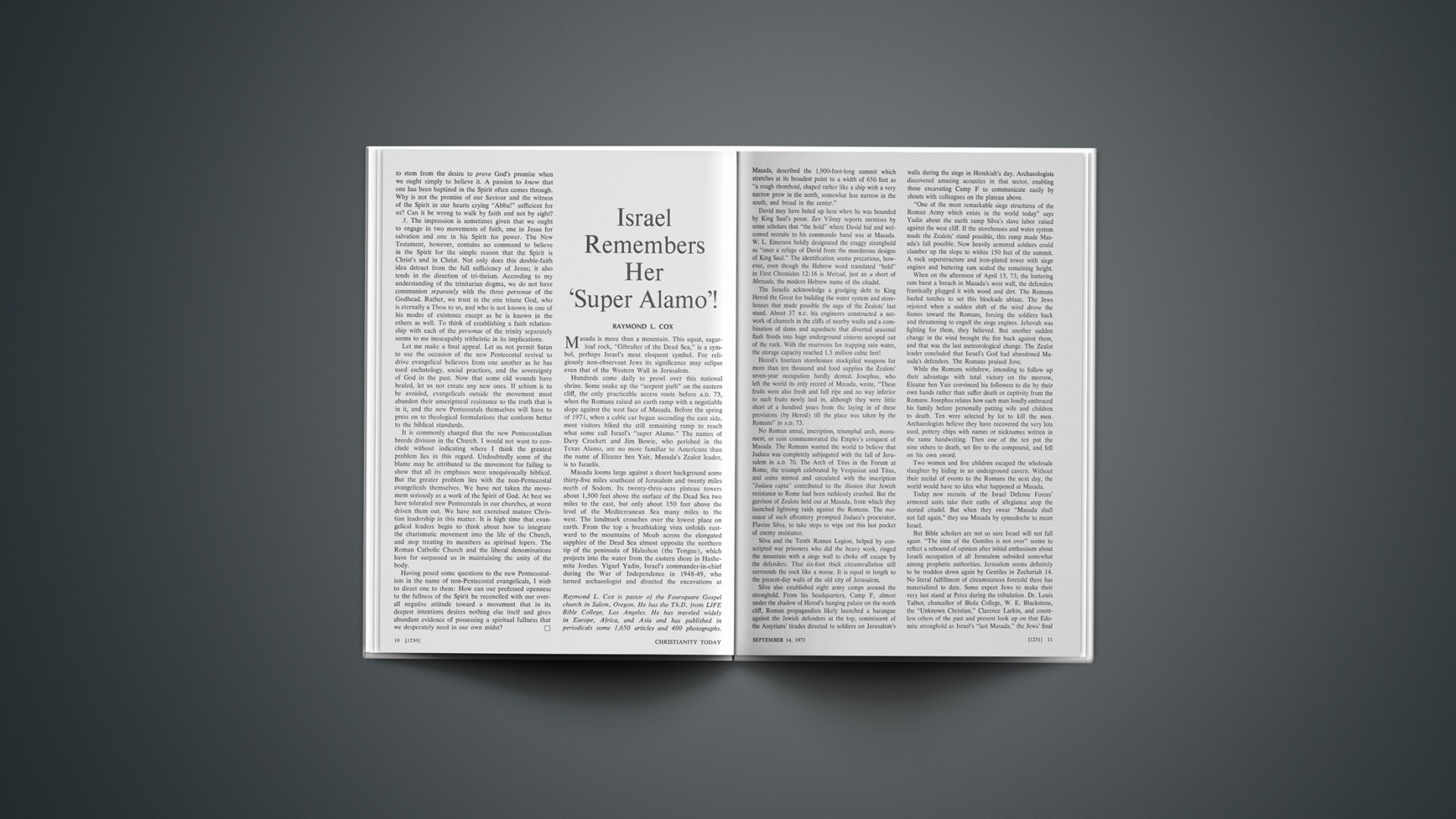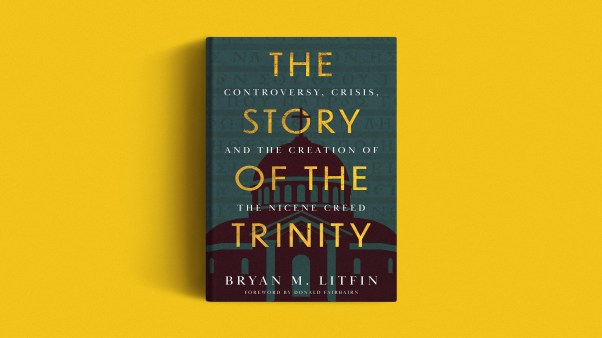Masada is more than a mountain. This squat, sugar-loaf rock, “Gibralter of the Dead Sea,” is a symbol, perhaps Israel’s most eloquent symbol. For religiously non-observant Jews its significance may eclipse even that of the Western Wall in Jerusalem.
Hundreds come daily to prowl over this national shrine. Some snake up the “serpent path” on the eastern cliff, the only practicable access route before A.D. 73, when the Romans raised an earth ramp with a negotiable slope against the west face of Masada. Before the spring of 1971, when a cable car began ascending the east side, most visitors hiked the still remaining ramp to reach what some call Israel’s “super Alamo.” The names of Davy Crockett and Jim Bowie, who perished in the Texas Alamo, are no more familiar to Americans than the name of Eleazer ben Yair, Masada’s Zealot leader, is to Israelis.
Masada looms large against a desert background some thirty-five miles southeast of Jerusalem and twenty miles north of Sodom. Its twenty-three-acre plateau towers about 1,500 feet above the surface of the Dead Sea two miles to the east, but only about 150 feet above the level of the Mediterranean Sea many miles to the west. The landmark crouches over the lowest place on earth. From the top a breathtaking vista unfolds eastward to the mountains of Moab across the elongated sapphire of the Dead Sea almost opposite the northern tip of the peninsula of Halashon (the Tongue), which projects into the water from the eastern shore in Hashemite Jordan. Yigael Yadin, Israel’s commander-in-chief during the War of Independence in 1948–49, who turned archaeologist and directed the excavations at Masada, described the 1,900-foot-long summit which stretches at its broadest point to a width of 650 feet as “a rough rhomboid, shaped rather like a ship with a very narrow prow in the north, somewhat less narrow in the south, and broad in the center.”
David may have holed up here when he was hounded by King Saul’s posse. Zev Vilnay reports surmises by some scholars that “the hold” where David hid and welcomed recruits to his commando band was at Masada. W. L. Emerson boldly designated the craggy stronghold as “once a refuge of David from the murderous designs of King Saul.” The identification seems precarious, however, even though the Hebrew word translated “hold” in First Chronicles 12:16 is Metzad, just an a short of Metzada, the modern Hebrew name of the citadel.
The Israelis acknowledge a grudging debt to King Herod the Great for building the water system and storehouses that made possible the saga of the Zealots’ last stand. About 37 B.C. his engineers constructed a network of channels in the cliffs of nearby wadis and a combination of dams and aqueducts that diverted seasonal flash floods into huge underground cisterns scooped out of the rock. With the reservoirs for trapping rain water, the storage capacity reached 1.5 million cubic feet!
Herod’s fourteen storehouses stockpiled weapons for more than ten thousand and food supplies the Zealots’ seven-year occupation hardly dented. Josephus, who left the world its only record of Masada, wrote, “These fruits were also fresh and full ripe and no way inferior to such fruits newly laid in, although they were little short of a hundred years from the laying in of these provisions (by Herod) till the place was taken by the Romans” in A.D. 73.
No Roman annal, inscription, triumphal arch, monument, or coin commemorated the Empire’s conquest of Masada. The Romans wanted the world to believe that Judaea was completely subjugated with the fall of Jerusalem in A.D. 70. The Arch of Titus in the Forum at Rome, the triumph celebrated by Vespasian and Titus, and coins minted and circulated with the inscription “Judaea capta” contributed to the illusion that Jewish resistance to Rome had been ruthlessly crushed. But the garrison of Zealots held out at Masada, from which they launched lightning raids against the Romans. The nuisance of such effrontery prompted Judaea’s procurator, Flavius Silva, to take steps to wipe out this last pocket of enemy resistance.
Silva and the Tenth Roman Legion, helped by conscripted war prisoners who did the heavy work, ringed the mountain with a siege wall to choke off escape by the defenders. That six-foot thick circumvallation still surrounds the rock like a noose. It is equal in length to the present-day walls of the old city of Jerusalem.
Silva also established eight army camps around the stronghold. From his headquarters, Camp F, almost under the shadow of Herod’s hanging palace on the north cliff, Roman propagandists likely launched a harangue against the Jewish defenders at the top, reminiscent of the Assyrians’ tirades directed to soldiers on Jerusalem’s walls during the siege in Hezekiah’s day. Archaeologists discovered amazing acoustics in that sector, enabling those excavating Camp F to communicate easily by shouts with colleagues on the plateau above.
“One of the most remarkable siege structures of the Roman Army which exists in the world today” says Yadin about the earth ramp Silva’s slave labor raised against the west cliff. If the storehouses and water system made the Zealots’ stand possible, this ramp made Masada’s fall possible. Now heavily armored soldiers could clamber up the slope to within 150 feet of the summit. A rock superstructure and iron-plated tower with siege engines and battering ram scaled the remaining height.
When on the afternoon of April 15, 73, the battering ram burst a breach in Masada’s west wall, the defenders frantically plugged it with wood and dirt. The Romans hurled torches to set this blockade ablaze. The Jews rejoiced when a sudden shift of the wind drove the flames toward the Romans, forcing the soldiers back and threatening to engulf the siege engines. Jehovah was fighting for them, they believed. But another sudden change in the wind brought the fire back against them, and that was the last meteorological change. The Zealot leader concluded that Israel’s God had abandoned Masada’s defenders. The Romans praised Jove.
While the Romans withdrew, intending to follow up their advantage with total victory on the morrow, Eleazar ben Yair convinced his followers to die by their own hands rather than suffer death or captivity from the Romans. Josephus relates how each man fondly embraced his family before personally putting wife and children to death. Ten were selected by lot to kill the men. Archaeologists believe they have recovered the very lots used, pottery chips with names or nicknames written in the same handwriting. Then one of the ten put the nine others to death, set fire to the compound, and fell on his own sword.
Two women and five children escaped the wholesale slaughter by hiding in an underground cavern. Without their recital of events to the Romans the next day, the world would have no idea what happened at Masada.
Today new recruits of the Israel Defense Forces’ armored units take their oaths of allegiance atop the storied citadel. But when they swear “Masada shall not fall again,” they use Masada by synecdoche to mean Israel.
But Bible scholars are not so sure Israel will not fall again. “The time of the Gentiles is not over” seems to reflect a rebound of opinion after initial enthusiasm about Israeli occupation of all Jerusalem subsided somewhat among prophetic authorities. Jerusalem seems definitely to be trodden down again by Gentiles in Zechariah 14. No literal fulfillment of circumstances foretold there has materialized to date. Some expect Jews to make their very last stand at Petra during the tribulation. Dr. Louis Talbot, chancellor of Biola College, W. E. Blackstone, the “Unknown Christian,” Clarence Larkin, and countless others of the past and present look up on that Edomite stronghold as Israel’s “last Masada,” the Jews’ final city of refuge, reasoning that Petra will be to the great tribulation what Masada was to the Jewish War. Jesus warned people in Judaea to flee to the mountains when the abomination of desolation desecrates the holy place (cf. Matt. 24:15, 16). Dr. Talbot insisted that Petra is the only area in the Holy land that answers the biblical description of the Jews’ “place prepared of God” (Rev. 12:6) to host Jews fleeing Antichrist. And Daniel 11:41 names Edom, where Petra nestles in mountains, as an area the Antichrist will not penetrate.
Whatever may be the prophetic dénouement, Masada fairly screams the warning that if a once godly nation forgets God and stretches forth hands to a strange god, the Almighty surely searches this out (cf. Psalm 44:20, 21). Perhaps the best peroration to the tragic story of Masada was written before 1857 by a man who never had the “privilege to visit that celebrated castle,” the explorer William M. Thomason. In The Land and the Book, which may still be the best volume of its kind about the Holy Land, he expressed his sentiments about Masada’s last stand:
Such tragedies are far more than mere incidents in man’s general history. They are the voice of the Almighty One, setting the seal of truth divine to a thousand admonitions and prophetic warnings scattered everywhere through his holy Word; and, thus regarded, there is no stronger evidence of the divine origin of the Bible than the seven books of Jewish Wars by Josephus.
George M. Marsden is associate professor of history at Calvin College, Grand Rapids, Michigan. He has the Ph.D. (Yale University) and has written “The Evangelical Mind and the New School Presbyterian Experience.”










